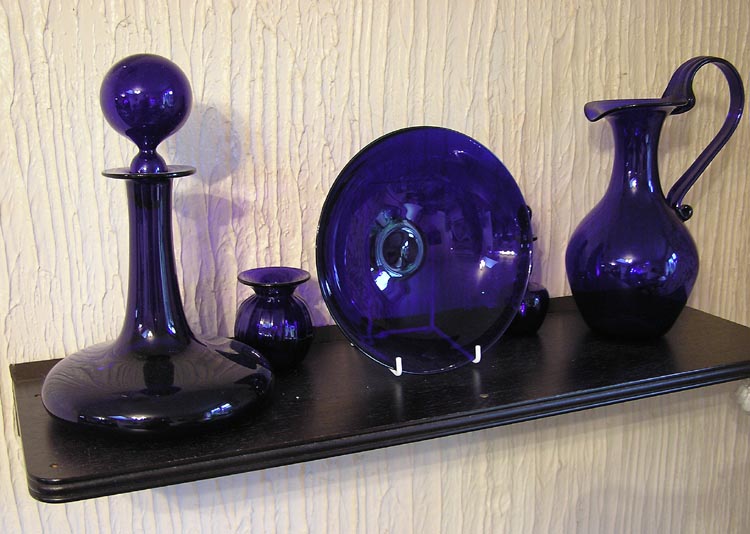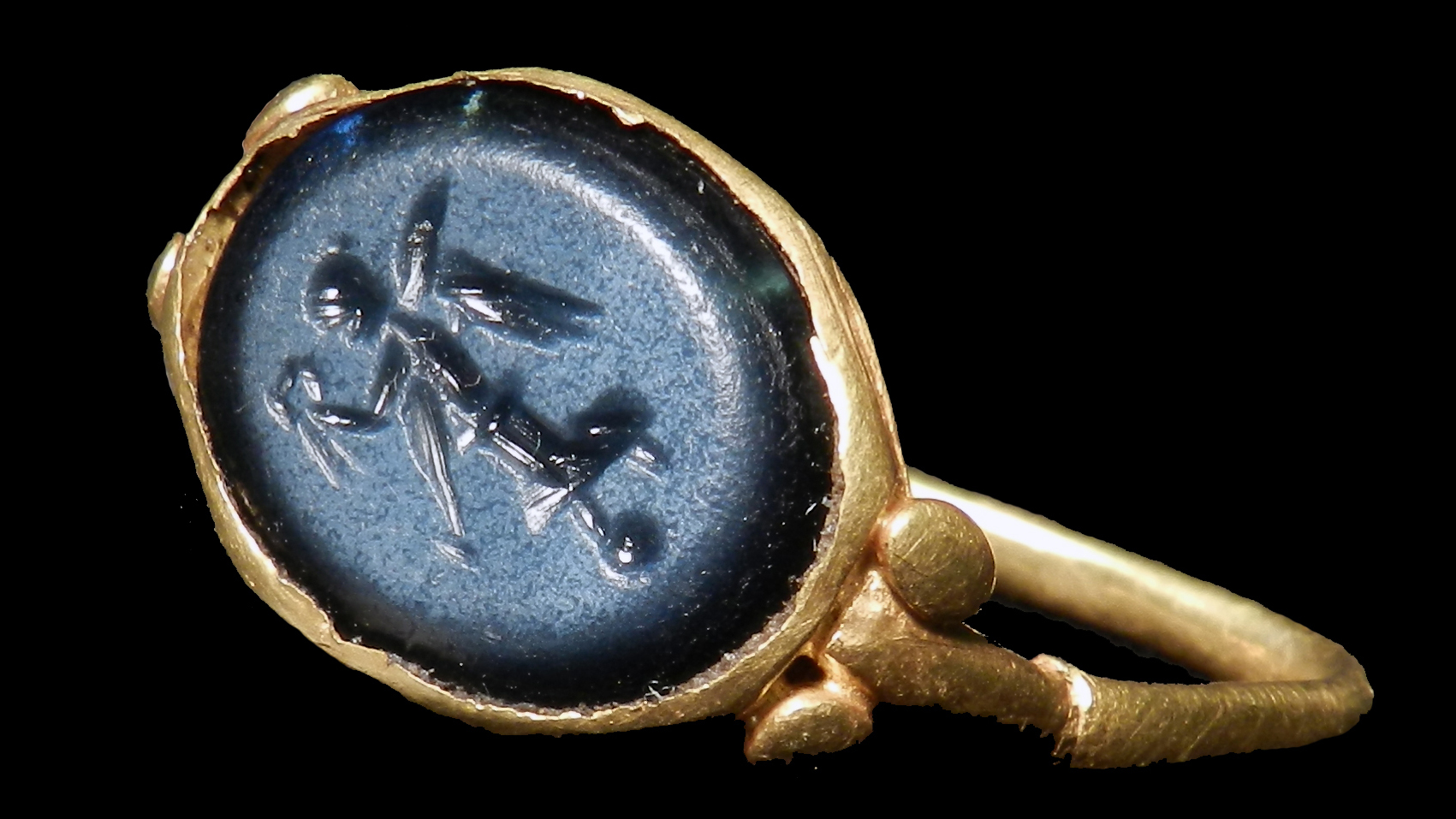Cobalt glass on:
[Wikipedia]
[Google]
[Amazon]
 Cobalt glass—known as "smalt" when ground as a pigment—is a deep blue coloured
Cobalt glass—known as "smalt" when ground as a pigment—is a deep blue coloured 
 The earliest known example of cobalt aluminate glass dates to a lump from about 2000 BC in
The earliest known example of cobalt aluminate glass dates to a lump from about 2000 BC in 
Internet Archaeology
# ''Smalt'', Bruno Mühlethaler and Jean Thissen, ''Studies in Conservation'', Vol. 14, No. 2 (May, 1969), pp. 47–61
JSTOR
Pigments through the Ages
Bromo-Seltzer: Cobalt Blue bottles - Brief Summary"M inside a circle" trademark: Maryland Glass Corporation, Baltimore (prolific producer of cobalt blue glass containers)
Internet Archaeology {{DEFAULTSORT:Cobalt Glass Cobalt Glass compositions Shades of blue
 Cobalt glass—known as "smalt" when ground as a pigment—is a deep blue coloured
Cobalt glass—known as "smalt" when ground as a pigment—is a deep blue coloured glass
Glass is a non-crystalline, often transparent, amorphous solid that has widespread practical, technological, and decorative use in, for example, window panes, tableware, and optics. Glass is most often formed by rapid cooling ( quenching ...
prepared by including a cobalt
Cobalt is a chemical element with the symbol Co and atomic number 27. As with nickel, cobalt is found in the Earth's crust only in a chemically combined form, save for small deposits found in alloys of natural meteoric iron. The free element, p ...
compound, typically cobalt oxide Cobalt oxide is a family of chemical compounds consisting of cobalt and oxygen atoms.
Compounds in the cobalt oxide family include:
* Cobalt(II) oxide (cobaltous oxide), CoO
*Cobalt(III) oxide
Cobalt(III) oxide is the inorganic compound with the ...
or cobalt carbonate, in a glass melt. Cobalt is a very intense colouring agent and very little is required to show a noticeable amount of colour.
Cobalt glass plates are used as an optical filter
Filter, filtering or filters may refer to:
Science and technology
Computing
* Filter (higher-order function), in functional programming
* Filter (software), a computer program to process a data stream
* Filter (video), a software component tha ...
in flame test
A flame test is an analytical procedure used in chemistry to detect the presence of certain elements, primarily metal ions, based on each element's characteristic flame emission spectrum (which may be affected by the presence of chloride io ...
s to filter out the undesired strong yellow light emitted by traces of sodium
Sodium is a chemical element with the symbol Na (from Latin ''natrium'') and atomic number 11. It is a soft, silvery-white, highly reactive metal. Sodium is an alkali metal, being in group 1 of the periodic table. Its only stable ...
, and expand the ability to see violet and blue hues, similar to didymium
Didymium ( el, , twin) is a mixture of the elements praseodymium and neodymium. It is used in safety glasses for glassblowing and blacksmithing, especially with a gas ( propane)-powered forge, where it provides a filter that selectively block ...
glass.
Moderately ground cobalt glass (potassium cobalt silicate)—called "smalt"—has been historically important as a pigment
A pigment is a colored material that is completely or nearly insoluble in water. In contrast, dyes are typically soluble, at least at some stage in their use. Generally dyes are often organic compounds whereas pigments are often inorganic compou ...
in glassmaking, painting, pottery, for surface decoration of other types of glass and ceramics, and other media. The long history of its manufacture and use has been described comprehensively. Cobalt aluminate, also known as " cobalt blue", can be used in a similar way.
Cobalt glass such as Bristol blue glass is appreciated for its attractive colour and is popular with collectors. It is used in the distinctive blue bottles of Harvey's Bristol Cream
John Harvey & Sons is a brand (trading name) of a wine and sherry blending and merchant business founded by William Perry in Bristol, England in 1796. The business within 60 years of John Harvey joining had blended the first dessert sherry, d ...
sherry and Tŷ Nant mineral water.

History
 The earliest known example of cobalt aluminate glass dates to a lump from about 2000 BC in
The earliest known example of cobalt aluminate glass dates to a lump from about 2000 BC in ancient Mesopotamia
The history of Mesopotamia ranges from the earliest human occupation in the Paleolithic period up to Late antiquity. This history is pieced together from evidence retrieved from archaeological excavations and, after the introduction of writing i ...
, very possibly intended for use as a pigment; it was rare until the modern era. Cobalt oxide Cobalt oxide is a family of chemical compounds consisting of cobalt and oxygen atoms.
Compounds in the cobalt oxide family include:
* Cobalt(II) oxide (cobaltous oxide), CoO
*Cobalt(III) oxide
Cobalt(III) oxide is the inorganic compound with the ...
smalt appears as a pigment in Egyptian pottery about five centuries later, and soon after in the Aegean region. In paintings, smalt has a tendency to lose its color over a long period, and is little used today. However, when used in ceramics for underglaze
Underglaze is a method of decorating pottery in which painted decoration is applied to the surface before it is covered with a transparent ceramic glaze and fired in a kiln. Because the glaze subsequently covers it, such decoration is completely ...
decoration, it keeps its colour well, and is the main blue used in blue and white pottery from a wide range of dates and areas, including Chinese blue and white porcelain from the Yuan and Ming dynasties, Renaissance Italian maiolica
Maiolica is tin-glazed pottery decorated in colours on a white background. Italian maiolica dating from the Renaissance period is the most renowned. When depicting historical and mythical scenes, these works were known as ''istoriato'' wares ...
and Delftware
Delftware or Delft pottery, also known as Delft Blue ( nl, Delfts blauw) or as delf,
is a general term now used for Dutch tin-glazed earthenware, a form of faience. Most of it is blue and white pottery, and the city of Delft in the Netherlands ...
.Encyclopedia Iranica, "Cobalt"

Chinese porcelain
Chinese ceramics show a continuous development since pre-dynastic times and are one of the most significant forms of Chinese art and ceramics globally. The first pottery was made during the Palaeolithic era. Chinese ceramics range from constru ...
used smalt glazes from the Tang dynasty
The Tang dynasty (, ; zh, t= ), or Tang Empire, was an imperial dynasty of China that ruled from 618 to 907 AD, with an interregnum between 690 and 705. It was preceded by the Sui dynasty and followed by the Five Dynasties and Ten Kingdom ...
onwards, though Chinese cobalt glass is found from the Zhou dynasty
The Zhou dynasty ( ; Old Chinese ( B&S): *''tiw'') was a royal dynasty of China that followed the Shang dynasty. Having lasted 789 years, the Zhou dynasty was the longest dynastic regime in Chinese history. The military control of China by ...
(1122–221 BC). Cobalt was used as a pigment in Central Asia
Central Asia, also known as Middle Asia, is a subregion, region of Asia that stretches from the Caspian Sea in the west to western China and Mongolia in the east, and from Afghanistan and Iran in the south to Russia in the north. It includes t ...
from the 13th century. A fragment of a mud painting in the ancient Tangut city of Khara-Khoto
Khara-Khoto (; mn, Khar Khot; "black city") is an abandoned city in the Ejin Banner of Alxa League in western Inner Mongolia, China, near the Juyan Lake Basin. Built in 1032, the city thrived under the rule of the Western Xia dynasty. It has b ...
has been found to contain smalt, judged to be dated between the 11th and 13th centuries. A large quantity of smalt was purchased for the decoration of the gallery of Francis I of France
Francis I (french: François Ier; frm, Francoys; 12 September 1494 – 31 March 1547) was King of France from 1515 until his death in 1547. He was the son of Charles, Count of Angoulême, and Louise of Savoy. He succeeded his first cousin on ...
at Fontainebleau in 1536. Smalt, normally now discoloured, is common in European paintings from the 15th to 17th centuries. For example, it is found in Hans Holbein the Younger's portrait of Sir William Butts (ca. 1540), in Michael Pacher
Michael Pacher ( 1435 – August 1498) was a painter and sculptor from Tyrol active during the second half of the fifteenth century. He was one of the earliest artists to introduce the principles of Renaissance painting into Germany. Pacher was a ...
's painting "The Early Fathers' Altar" (ca. 1483), and in the frescos of Domenico Ghirlandaio (1449–1494).
The invention of a European smalt process has traditionally been credited to a Bohemian glass
Glass is a non-crystalline, often transparent, amorphous solid that has widespread practical, technological, and decorative use in, for example, window panes, tableware, and optics. Glass is most often formed by rapid cooling ( quenching ...
maker named Christoph Schürer, around 1540–1560. However, its presence in Dieric Bouts
Dieric Bouts (born c. 1415 – 6 May 1475) was an Early Netherlandish painter. Bouts may have studied under Rogier van der Weyden, and his work was influenced by van der Weyden and Jan van Eyck. He worked in Leuven from 1457 (or possibly earlier) ...
' '' The Entombment'' from circa 1455 proves that it was used at least a century earlier.
In England and Scotland, smalt was added to laundry starch. James VI and I
James VI and I (James Charles Stuart; 19 June 1566 – 27 March 1625) was King of Scotland as James VI from 24 July 1567 and King of England and Ireland as James I from the union of the Scottish and English crowns on 24 March 1603 until ...
considered awarding a patent for making a "blue azure" product for this purpose in Scotland in February 1609.David Masson
David Mather Masson LLD DLitt (2 December 18226 October 1907), was a Scottish academic, supporter of women's suffrage, literary critic and historian.
Biography
He was born in Aberdeen, the son of William Masson, a stone-cutter, and his wi ...
, ''Register of the Privy Council of Scotland, 1607-1610'', vol. 8 (Edinburgh, 1887), p. 559.
The process used for producing cobalt smalt glass at the Blaafarveværket
Blaafarveværket, or the Blue Colour Works, was a mining and industrial company located at Åmot in Modum in Viken county, Norway, which existed from 1776 to 1898. The works mined cobalt ore and manufactured by smelting blue cobalt glass ( sma ...
industrial manufacturing center in Norway in the 19th century has been documented as smelting cobalt oxide together with quartz and potassium carbonate. The result was an intensely blue glass-like substance that was ground and sold to producers of glassware and porcelain.
See also
* Cobalt blue *Cobalt
Cobalt is a chemical element with the symbol Co and atomic number 27. As with nickel, cobalt is found in the Earth's crust only in a chemically combined form, save for small deposits found in alloys of natural meteoric iron. The free element, p ...
* Bristol blue glass
Notes
Further reading
# ''An Archaeometallurgical Explanation for the Disappearance of Egyptian and Near Eastern Cobalt-Blue Glass at the end of the Late Bronze Age'', Jonathan, R. Wood and Hsu Yi-Ting, 2019, ''Internet Archaeology'' 52Internet Archaeology
# ''Smalt'', Bruno Mühlethaler and Jean Thissen, ''Studies in Conservation'', Vol. 14, No. 2 (May, 1969), pp. 47–61
JSTOR
External links
Pigments through the Ages
Bromo-Seltzer: Cobalt Blue bottles - Brief Summary
Internet Archaeology {{DEFAULTSORT:Cobalt Glass Cobalt Glass compositions Shades of blue